

The EMO Agency, Inc. 400 Rosedale Ct., Warrenton, VA 20186 National 800-347-3552 West Coast 818-848-0443 www.RIDEEMO.com Top-rated underwriters with time-tested products… providing excellent service for more than 40 years. Call Blake Boyd: 803-513-4037









Stonemint Farm 54+ Ac | Live Oaks | 3 Fenced Pastures Shed Row w/ Lounge & Screened Porch The Preserve at Whisper Farm 3 Parcels, 4.27 to 35+ Acres Close to Foxhunting & Polo Byerley Stables on Audubon 3+ Acres with 2 Barns - 42 Stalls Across the Street From Bruce’s Field Sea Horse Farm 8.01 Ac | 5 Stall Barn | 3351 SF Home Enjoy Your Sporting Life 803.998.0198 SullivanTurnerTeam.com Stunning Properties for Your Sporting Life in Aiken, South Carolina! Trust the Market Leader's #1 Team in Aiken, SC Leader in Luxury Real Estate Sales Cissie Sullivan and Tracey Turner pair their love of sport with a combined 42+ years of experience assisting buyers and sellers of farms, historic homes & luxury estates. Whether your goal is to earn you colors with the one of Aiken's local hunts, show your hunter or jumper at Bruce's Field, enjoy a hack in Hitchcock Woods or a round of golf on one of Aiken's historic golf clubs, Cissie and Tracey will bring their trusted expertise to guide you to the perfect property to complement your lifestyle! info@SullivanTurnerTeam.com
Tracey Cissie





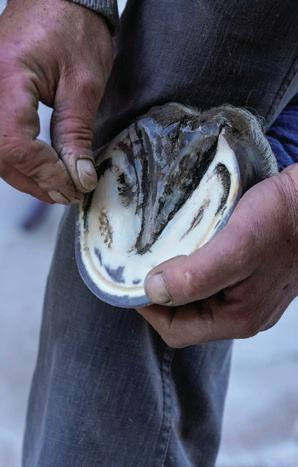


IN THIS ISSUE 7 LETTER FROM THE EDITOR 8 GO HORSE SHOW 12 GROWING UP SHOWING 18 EQUESTRIANS: GEORGIA COYLE 22 HORSES THAT HEAL 32 UNDER 21: TAYLOR LOVETTE 34 MODERN HOOF CARE 42 ART OF TAMMY TAPPAN 48 INDEX OF ADVERTISERS 50 PARTING SHOT 34 22 8 42 6 The Carolinas Equestrian Spring 2024


Spring 2024; Volume 10, Issue 2
Editor
Lauren Allen
Publisher
Pam Gleason
Layout & Design
Larchwood Productions
Contributors
Caroline Allen
Lauren Allen
A & S
Photography
Sarah Welk Baynum
Maria Cobb
Pam Gleason
Tyler Graham
Gary Knoll
Jessica O’Connor
Robb Scharetg
Natalie Suto
Advertising
Lauren Allen
803-240-1275
Pam Gleason
803-643-9960
Ashley Haffey
607-743-1309
General Inquiries
Lauren Allen
803-240-1275
thecarolinasequestrian@gmail.com
Cover
Johanna Hersacher competing in the leadline class on her pony, Made From Scratch. Aiken Horse Show in the Woods, 2024
Photography by Pam Gleason
Like us on Facebook:
The Carolinas Equestrian Magazine
Intragram: CarolinasEquestrianMag Web: TheCarolinasEquestrian.com
The Carolinas Equestrian (TCE) 1176 Old English Road Lugoff, SC 29078
No part of this publication may be reproduced in any form without the express written consent of the copyright owner.
The Carolinas Equestrian does not necessarily endorse the views and perceptions of contributors or advertisers.
From the Editor
Spring is the season of beautiful beginnings and growth, whether stepping into the next division or forging a partnership with a new horse. What could be more fun than being at the very start of a riding journey that could lead to colorful ribbons and glory? In this issue, we look at horse shows in the Carolinas. The horse show world confers many benefits, especially to those who keep their eye on the real prize: their partnership with their best friend, the horse.

Horse lovers may say that their horses are therapy, but some horses and handlers are especially committed to supporting those with special needs. We explore a sampling of the various equine-assisted services located in our area. From mental and behavioral to physical therapy, horses do so much for humans in so many beautiful ways.
As always, we want to be sure to offer practical information for our readers, and this issue we take a hard look at our horses’ hooves. Equine veterinary podiatrist Dr. Shawn Morrell gives his insight, as well as Dr. Shelley Onderdonk, a veterinarian and barefoot advocate, whose guiding principle is to keep horses as natural as possible.
Artist Tammy Tappan celebrates the healing power of the horse with life-size bronze sculptures and distinctive horse portraits. Read about her fascinating story, and if you visit Tryon International Equestrian Center in Mill Spring, North Carolina, step into her studio and check out her work.
What makes an equestrian outstanding? The size of their love for the horse has to be one answer. Our “Under 21” subject, Taylor Lovette, rides at Dream Riders in Lexington, South Carolina, where her partnership with her favorite horse brings out the best in them both. Our “Equestrian of the Carolinas,” Georgia Coyle, also understands the therapeutic value of laying hands on a horse: she has taken care of some of the top horses in the country in her career as an international showjumping groom and as a breeding and layup farm manager.
We hope you love these stories and pictures. Please reach out to us through our website at TheCarolinasEquestrian.com or on Facebook or Instagram and tell us about people we need to talk to, events we need to cover, or places we need to go see.


Lauren Allen, Editor
The Carolinas Equestrian is owned by The Carolinas Equestrian LLC.

Go Horse Show Showing in the Carolinas
By Pam Gleason
Lovers of competition will tell you that there is no greater thrill than testing your skills at a horse show. Showing does more than simply give people a chance to prove whose horse or whose riding is best. It is also an opportunity to engage with a wider community of horsemen. It gives riders goals to strive for, and tangible results from their hard work. For some people, riding and training at home can be enough, but for those who truly want to be their best, horse shows are an invaluable motivator. Finally, horse shows can provide exposure to some of the best riders in the country and the world, who may be showing at the same grounds, and even at the same time, as people riding at lower levels.
For riders in the Carolinas, there are shows for every horse and at every level, from leadline all the way up to international showjumping. All disciplines are available: hunter/jumpers, western, dressage, saddleseat, driving and so on. There are shows that are recognized by national and international organizations, shows
sanctioned by regional and local associations, and unrecognized schooling shows, which can be less intimidating (and more affordable) for greener horses and riders. Finally, the Carolinas also offer a number of historic, old-fashioned shows, giving today’s horsemen the flavor of times gone by. Whatever your level and however you enjoy your horse, there is probably a show for you.
Historic Horse Shows
The oldest show in the Carolinas is South Carolina’s Aiken Horse Show, established in 1916 and held every spring in a historic grassy show ring about a mile into Aiken’s iconic Hitchcock Woods. Although the show is not recognized by any association and there are no points to win for year end awards, the “Show in the Woods” always attracts accomplished exhibitors from around the region. The Blowing Rock Horse Show in North Carolina is another historic show that brings top riders and horses from near and far. Blowing Rock was founded 1923 and includes two
8 The Carolinas Equestrian Spring 2024
Pam Gleason


completely separate types of show: a Saddlebred show and a USEF rated hunter/jumper show. Blowing Rock is a resort area in the Blue Ridge Mountains, where the summer weather is noticeably cooler than it is in most parts of the Carolinas. A trip to the show can seem like a voyage to a different country – and even to a different era.
Regular Horse Shows
The highest level of showing in the Carolinas is in North Carolina at the Tryon International Equestrian Center, host of the World Equestrian Games in 2018. Over the summer months, Tryon International holds FEI jumper classes up to the four-star level, attracting Olympic athletes from many nations to their manicured show rings.
In South Carolina, Aiken is a hotspot, with regular USEF rated shows at Bruce’s Field in the Aiken Horse Park as well as at the Highfields Event Center, which is the home base for Progressive Show Jumping. Stableview, also in Aiken, has a
new set of hunter/jumper shows called the In and Out series, awarding $25,000 in prize money at each show.
Over in Camden, the South Carolina Equine Park (SCEP) has a full schedule of horse shows for a variety of disciplines. Progressive Show Jumping also puts on shows there, as well as at Mullet Hall on Johns Island.
In North Carolina, the Carolina Horse Park in Raeford, near Southern Pines, holds the Sedgefield hunter-jumper shows in addition to its renowned horse trials. Meanwhile, Triangle Farms in Raleigh has a number of shows during the year, and the prestigious Jump for the Children event to raise money for Duke Children’s Hospital each November.
There are also regular shows organized by the Union County Saddle Club in Monroe, and a variety of shows at the Foothills Equestrian Nature Center (FENCE) in Tryon.
One of the great things about horse shows in the Carolinas is that even entry level shows are often
SPring 2024 The Carolinas Equestrian 9
Above Left: Jack Huey with DaddsWinnBingoEdition at the Palmetto Paint Horse Club March Madness, 2024 SCEP. Above Right: Olympian Rodrigo Pessoa, FEI **** showjumping at Tryon International Opposite Page: Junior/Amateur Hunter Derby at the Aiken Spring Classic, Highfields in Aiken.
Jessica O’Connor
held at world class facilities. For instance, Tryon International hosts many of the Harmon Classics Horse Shows, which have divisions down to walktrot and cross rails. Sarah Madden, marketing and public relations manager at Tryon International, says she appreciates the opportunity.
“As both a staff member and a low-level competitor who didn’t grow up with the resources to compete often, I have taken advantage of local shows hosted at the venue to compete at one of the world’s best showgrounds,” she said. “As a child, I couldn’t even imagine such a wonderful place for my horse-crazy self to get to enjoy every day. The fact that beginner cross-rails competitors can compete alongside seasoned Olympians, and that spectators can be immersed in the equestrian industry in such an accessible way is still amazing to me.”
Janet Black, who runs the Foothills Equestrian Show Service, has a show series with year end awards at FENCE in Tryon and at the South Carolina Equine Park in Camden. Black prides
herself on offering well-run shows for riders from beginner through advanced at an affordable price and at top notch facilities.
“I feel my shows offer a great experience,” she said. “Walk/trot riders are judged by the same officials as the professionals and medal riders. It’s a family atmosphere and we are seeing more RV spaces being used, so the entire family is on the show grounds tailgating after the show. Offering circuit awards provides an end goal and special recognition.”
Go Horse Show
Are you ready to show? Whatever your discipline or level, there is probably a show for you. If you are not quite ready yourself, why not go watch? Any level of horse show can be inspiring, and it will put you in touch with other people who share your equestrian passion. Horse shows are good for the equestrian industry, good for your horsemanship, and good for the community as well. So go horse show. You will be glad you did.


10 The Carolinas Equestrian Spring 2024
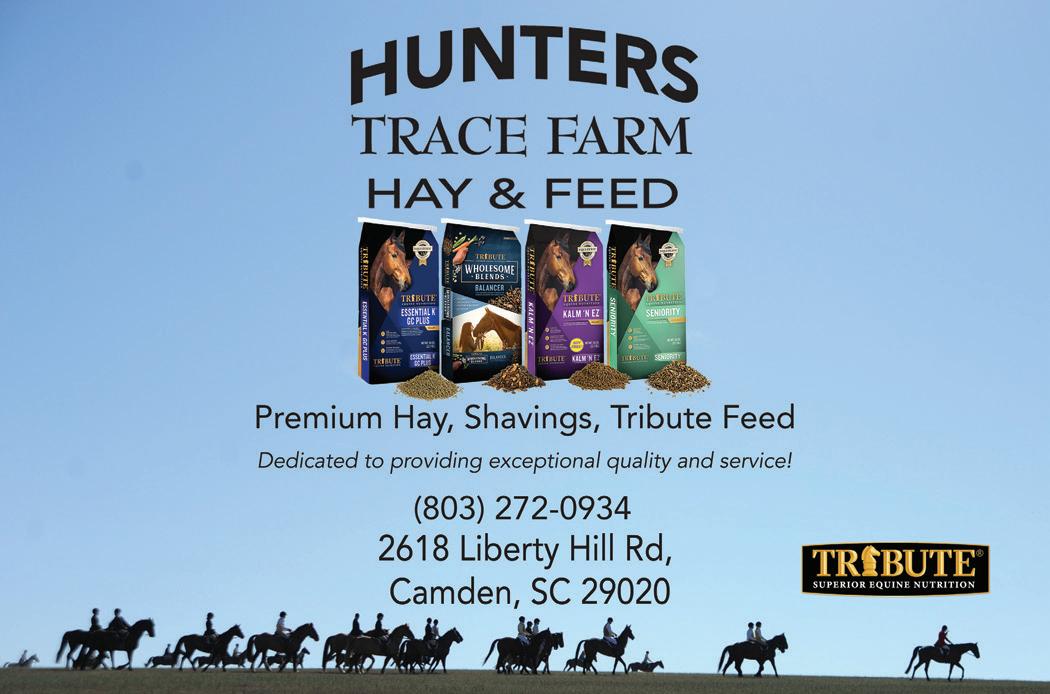

SPring 2024 The Carolinas Equestrian 11
Horse people are tough, and horse people who show are even tougher. There are many challenges: Early mornings caring for, grooming and braiding your horse, navigating hectic warm-up rings, memorizing jump courses under pressure, fighting nerves in the show ring, handling success or defeat with equal grace and good temper.
For young people, going to horse shows can teach life lessons: sportsmanship, maturity, responsibility, and so on. Showing horses is about more than just competition. Riding in shows teaches special skills that may help horse people face other challenges in life, both in and out of the show ring.
Showing at an Early Age
Riders competing in their first leadline classes can be as young as two, or even younger. The littlest leadline competitors may not even understand what they are doing, but once they get the horse show bug, it can be hard to shake, even if that first show didn’t go so smoothly.
“Both myself and my sister Liza have been riding since before we can remember and started competitively showing at around age 5

or 6,” said Celia Cram, 20, who is a student at Savannah College of Art and Design where she rides on the NCAA equestrian team. She and her younger sister Liza, a freshman at the University of Georgia and a member of their equestrian team, are the daughters of Rick and Cathy Cram who own and run Progressive Show Jumping and Highfields Event Center in Aiken, South Carolina.
“The first time I can remember showing was in the leadline class at the Aiken Spring Classic on a borrowed pony,” Celia continued. “He was spinning around in circles because he saw the mounted officer carrying the flag.”
“My first memory of showing was also in the leadline on our pony Good Golly Miss Molly at the Aiken Spring Classic,” added Liza Cram. “Molly was our first real pony, and Celia showed her in the walk trot at the same show.”
Some young riders know they want to ride horses at the beginning, but don’t plan on showing. However, for some riders that start out thinking this way, the horse showing bug eventually bites them.
“I started riding when I was 12,” said Jacqui Lanier, now a lawyer based in the Greenville,
12 The Carolinas Equestrian Spring 2024
Pam Gleason
South Carolina area. “My dad had horses when he was younger and because of this, I was always interested in horses and riding. When I started taking weekly lessons, I promised that I would not want to get involved in horse shows, but that quickly changed.”
Lanier showed hunters and jumpers growing up, but stopped riding for several decades while establishing her career and family. She has gotten back into the ring in recent years and today, she shares the horse show experience with her teenage daughter Jazzy.
“I still love to show. Whether I am terrible or great, I love the entire experience,” she said. “The preparation, the next level relationship you develop with the horse that you travel with and take care of at shows – it’s all my favorite! I am so glad that I learned how fun horse showing can be, and of course, I am competitive. I truly love the entire experience of taking my horse out, seeing everyone else’s horses, and being surrounded by people who all love the same thing.”
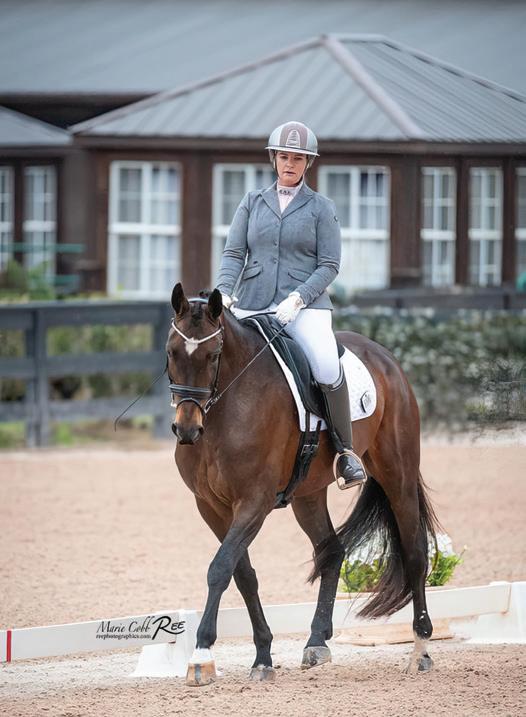

Life Lessons
“My strong work ethic is directly related to the long hours of training and showing that resulted from growing up on the circuit,” said Celia Cram. “I think some lessons that I learned are being humble and adaptable. These two traits have gotten me very far in life.”
Liza agrees. “Everyone has a bad day, including your horses, and it’s always important to take what you’ve learned and grow from it. Every day is a new chance to be the best you can be and give your horse a positive experience. I’ve learned to be appreciative of every opportunity and take nothing for granted.”
For Lanier, showing horses gave her bravery and resilience that she carried into adult life.
“Horse showing has been everything to me. I learned how to work hard, to care about something beside myself, and to do things even if I was scared at first,” she said. “Today, it is a reprieve from all the demands of being a mom and business owner as well as giving myself and
SPring 2024 The Carolinas Equestrian 13
Above: Lydia Groome & Jazzy Lanier, South Carolina Equine Park, Camden
Below: Jacqui Lanier showing at Tryon International
my daughter common ground and amazing experiences to share.”
Teamwork and Sportsmanship
While showing horses is technically not a team sport, it can help develop a rider’s ability to work as a team. The most important aspect of this teamwork is with the horse, but young riders also learn to be supportive of their peers.
“As I watch my daughter show, I see the other girls she rides and shows with in our barn all cheer for each other,” said Lanier. “They go through the entire show process together from schooling to caring for and feeding the horses all weekend as a team. They are truly vested in and celebrate each other’s success.”
“I think being part of a team, whether it’s your barn or your college team, means you have a whole support system and family,” said Liza Cram. “Not only are they there to cheer you on, they’re also there to help with any difficulties along the way. I think this has shown me that no matter what, there’s always someone on your team.”
The Person They Are Today
Jacqui Lanier attributes much of her professional success to the work ethic she developed during her hours at the barn growing up. “I also think it has

helped me, as an adult, to understand work is not everything, that balance is important, and that you must take time for the things in life that you love and that bring you joy.” Today, Lanier gives back to the sport by serving on the Board of Directors of the Foothills Riding Club in Landrum, South Carolina. In the fall of 2023, she became the owner of the Motlow Creek Equestrian Center in Campobello, South Carolina.
Celia and Liza Cram believe that their horse show careers have had a profound influence on their lives and their personalities.
“I can positively say that I would not be the same person I am today without growing up at horse shows,” said Liza Cram. “I made forever friends, learned from my many mistakes and successes, and I would not change a thing.”
Celia Cram agrees with her sister. “I think that your ability to succeed in this sport is not necessarily based on how early you start, but rather how hard you work. We were fortunate enough to start very early though, and have been working hard day in and day out to better ourselves from the beginning. We both appreciate having to work for everything we have and are grateful for every opportunity and experience we have been given.”

14 The Carolinas Equestrian Spring 2024
Celia and Liza Cram at a horse show at Highfields, Aiken





SPring 2024 The Carolinas Equestrian 15 PBR® Tryon Chute Out June 21-22, 2024 WCRA Rodeo Carolina October 3-5, 2024 Earl Scruggs Music Festival Aug. 30-Sept. 1, 2024 Winterfest Village Nov. 29-December 22, 2023 Shadrack’s Christmas Wonderland Drive-thru Light Show Nov. 21, 2024-Jan. 1, 2025 Signature Events Mill Spring, NC | Tryon.com @TryonResort Saturday Night Lights May - October, 2024
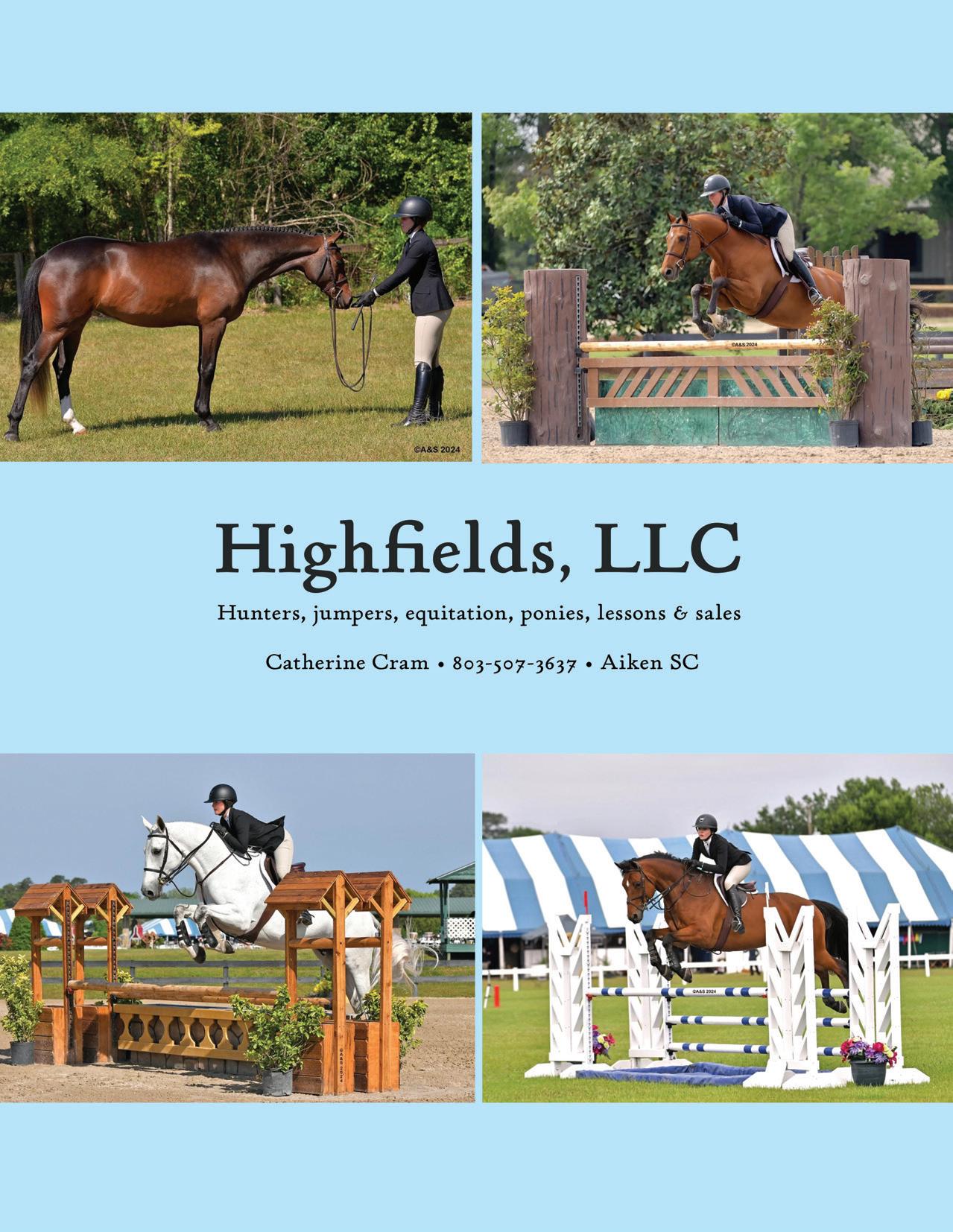
16 The Carolinas Equestrian Spring 2024
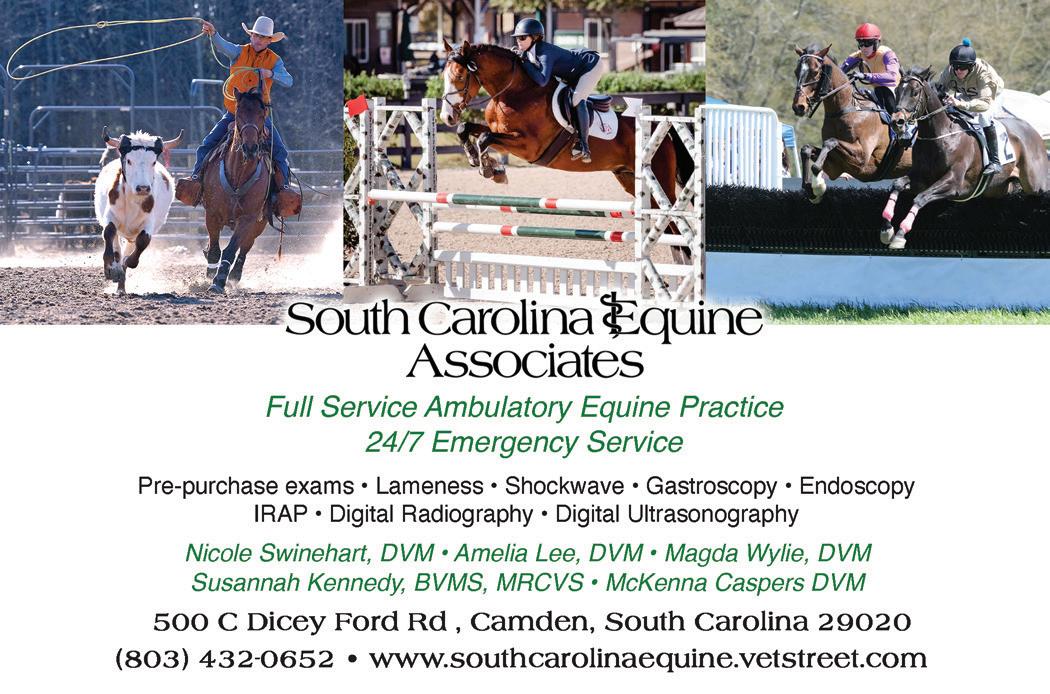
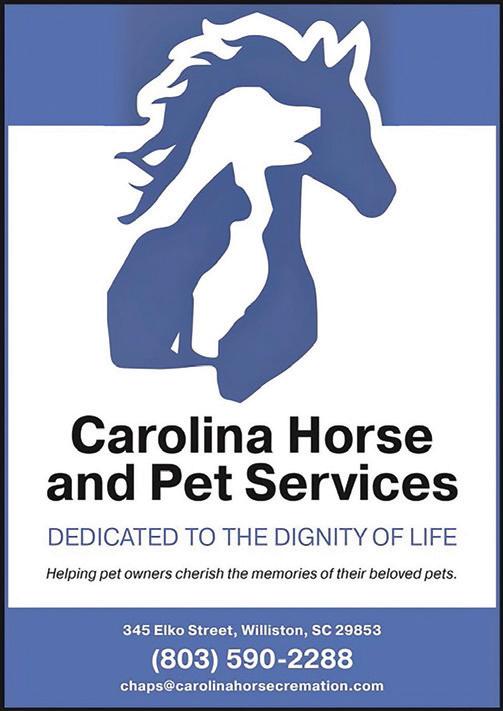

SPring 2024 The Carolinas Equestrian 17
Equestrians of the Carolinas
Georgia Coyle
By Lauren Allen
Georgia Coyle has taken care of some the best horses in the world, all over the world. If you know anything about the golden age of showjumping, then names like Rodney Jenkins, Ronnie Beard and Robert Ridland, or horses such as Idle Dice and Southside give you a thrill. Georgia Coyle was there for all of it and she is still getting her horse fix at 70 years old at the breeding and layup farm she runs in Wingate, North Carolina with her husband Chris Coyle. “I’ve been lucky and I’ve had fun, and of course, worked hard,” she says.
Georgia remembers her very first experiences with horses when she and her sister were put in a little western saddle for a pony ride. “The first touch or feel you get, you’re either bitten or you’re not” says Coyle, and she was bitten hard. She lived in a regular neighborhood in the Charlotte area, but it wasn’t long before her father picked up a little Quarter Horse mare named Ginger Ale. She rode where the Mecklenburg Hounds used to ride on land now filled with endless development and the shops of the Charlotte Arboretum.
responsible for the care of the renowned showjumper Idle Dice, if his regular groom didn’t go to the show. “Everybody woke up at 3:30,” she laughs. “There were some long hours.” She went to the FEI World Championships in 1974 in Hickstead, England. “Idle Dice was a great big horse, but he was very gentle. When he went in the ring with Rodney it was like watching poetry.”
Back then, everyone was responsible for braiding their own horses, but two friends of Georgia’s started one of the very first horse show braiding services, and she went with them to follow the circuit. “We were so close, all of us, we were like carnival people where every week we went to a different show.”
“There is something about spending time with a horse and making them look good and feel good. It’s just very rewarding.”
In high school, Coyle had a dark bay Thoroughbred mare named Wine Bearer that she showed in the equitation, junior hunters and regular hunters. She trained with Nora Cooke at Cedar Hill Farm, but when she graduated high school, she didn’t have the money to continue showing and she didn’t want to lose her connection with horses, so she went to work for the legendary judge and trainer Jimmy Lee as a groom.
Eventually Georgia took a job with Rodney Jenkins, where she would occasionally be
Then, Georgia was asked to help Ronnie Beard and Robert Ridland at Winter Place Farm in Maryland. When Ridland went to Europe to compete with his champion jumper Southside, she went along, and then accompanied the U.S. team to the Montreal Olympics in 1976. When Winter Place Farm folded, Georgia came home to the Southern Pines area. She was quickly snapped up by the jumper phenomenon Michelle McEvoy (now Michelle Grubb) who had recently opened a stable in Pinehurst, North Carolina.
Georgia settled down a bit after she met Chris. They married in 1983, and had two daughters. He worked at prestigious Standardbred breeding farms in New York and New Jersey for many years, but eventually, the couple returned to North Carolina and opened Olive Branch Farm.
“It’s been mostly Standardbreds since then. Trotters and pacers, some of the top horses in the
18 The Carolinas Equestrian Spring 2024
Right: Georgia with Robert Ridland’s Southside on their way to the Montreal Olympics in 1976
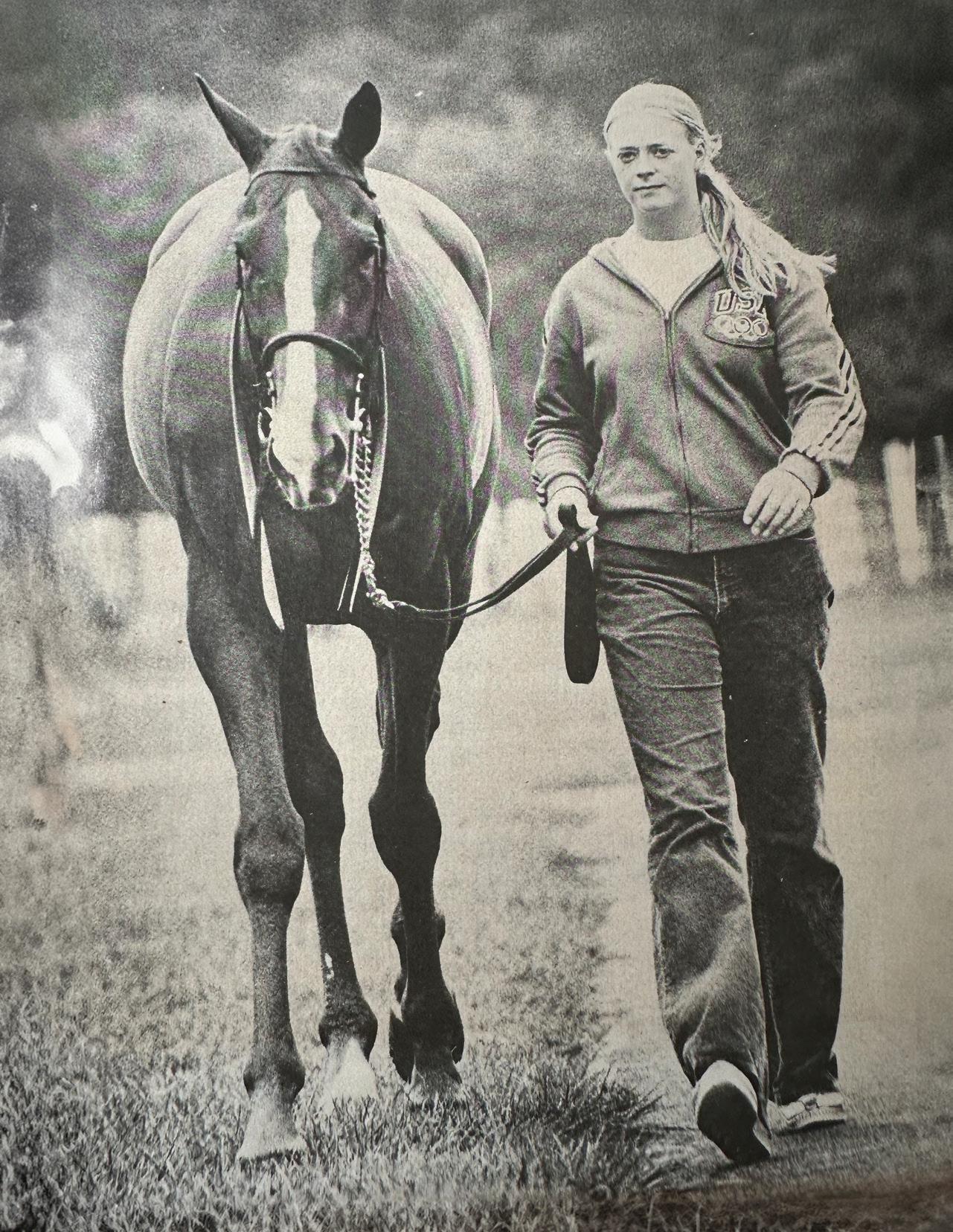
world come to the farm to rest between races. We don’t train anything here; horses just come in to take a break for a month or two, and we do the mare and foal thing. We’ve been averaging 20-30 foals a year.”
Georgia says she is slowing down a little and travelling more and she enjoys visiting her two granddaughters. But she doesn’t seem to be slowing down that much: “My new venture is I have a 5-year-old gelding in training to be an event horse. That’s a new world for me, but it’s fun. He is in training with Laura Orlowski in the Gastonia area.”
Her event prospect, Cool Enough, is a homebred. Georgia says she had a retired Standardbred mare named Cool Character that she bred to a Thoroughbred stallion. The pairing was inspired when Georgia heard a song on the radio called “Cool Enough.”
“I thought, that would have been a perfect name for one of her babies, so I was like, I could still breed her.” She laughs, “I bred a horse just so I could name it Cool Enough.”
Cool Enough is now almost 17 hands tall and competing Beginner Novice. “He’ll have to be sold at some point, but I just want him to learn a lot and get to as many shows as I can get to and be his groom.”
It seems that grooming horses is truly what Georgia was born to do. She also has a horse named Fields of Gold, that she bought for $800 from her bank teller because owning a palomino was on her bucket list. She doesn’t ride as much anymore but she still loves to care for him, even after all the years of caring for horses professionally.
“I go out and groom him and I have fun doing that. It’s therapeutic—there is just something about spending time with a horse and making them look good and feel good. It’s just very rewarding.”




20 The Carolinas Equestrian Spring 2024
Above: Riding Wine Bearer at the Blowing Rock Horse Show Below: With Laura Orlowski and Cool Enough
Above: Georgia with her sister, Mary.

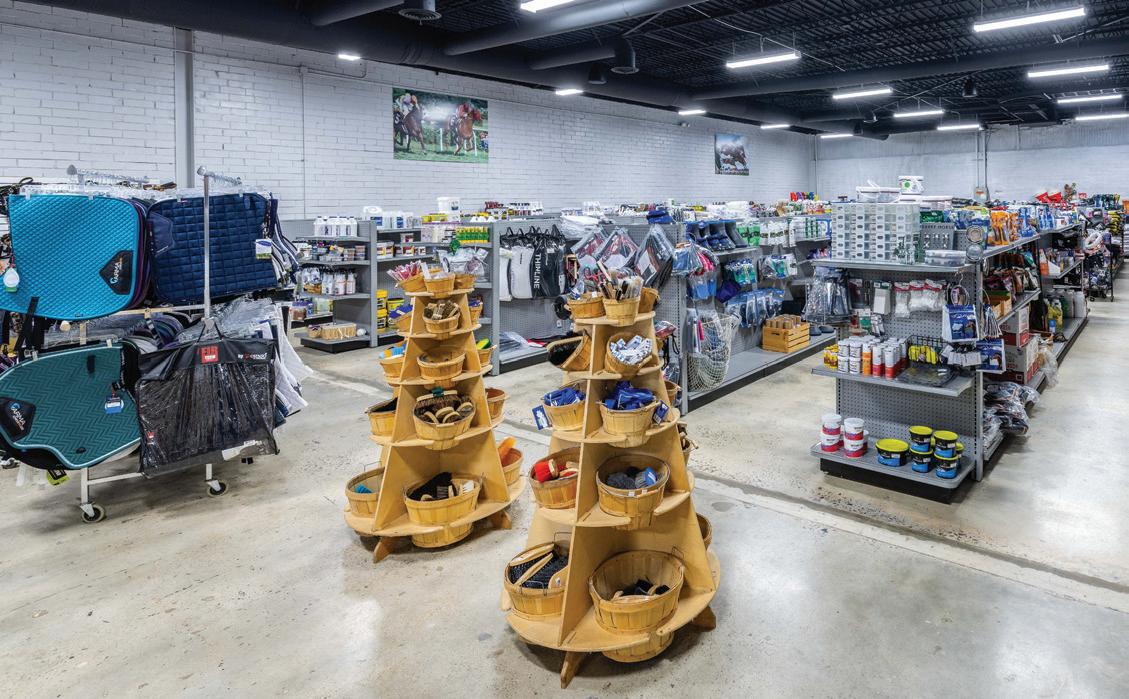
SPring 2024 The Carolinas Equestrian 21 YOUR EQUINE DESTINATION FOR QUALITY AND SERVICE FOR THE PAST 40 YEARS. 803-649-6583 1090 East Pine Log Road, Aiken, SC 29803 www.aikensaddlery.com

Horses are Good For Us . . .
Visiting with the herd at the Marley Project in Camden, South Carolina during Horses For Mental Health Month.

. . . In So Many Ways
Equine-Assisted Services in the Carolinas
by Lauren Allen
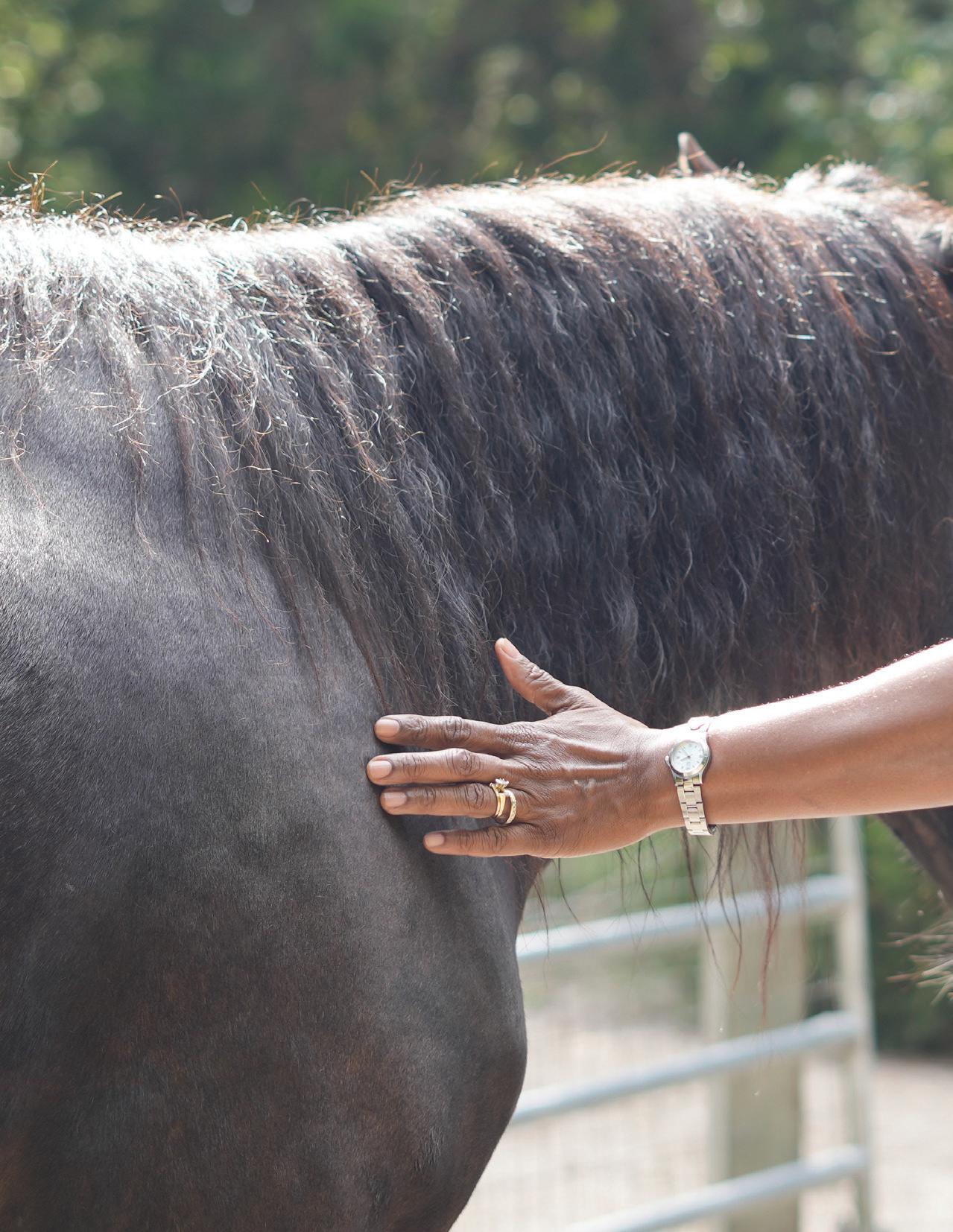 The Marley Project
The Marley Project

Every equestrian knows that horses heal us on a spiritual level, sometimes in ways we don’t even know we need. But some horses take their jobs as therapists very seriously. These sainted equines help a wide variety of people, from individuals with physical or cognitive disabilities to veterans and other people who have been deeply traumatized or injured, as well as those with behavioral issues or mental health diagnoses.
The size, strength and sensitivity of horses makes them amazing partners for all sorts of therapeutic modalities, and there is a tremendous variety of programs right here in the Carolinas. Several national organizations provide guidance and accreditation for equine-assisted services. The Professional Association of Therapeutic Horsemanship (PATH) International is one of the best known. PATH sets rigorous standards and offers education nationwide. The organization divides equine-assisted services into four basic categories:
• Therapeutic/Adaptive Horsemanship: adaptive equestrian sport includes riding, driving and interactive vaulting. According to the PATH literature “Disability does not have to stop anyone from riding or caring for horses.” The horse moves the rider’s body in ways that mimic the human gait and allows people with limited mobility to feel the power of Pegasus. Equine-assisted therapy can improve strength and coordination as well as offer opportunities to build confidence and enjoy the outdoors. Adaptive horsemanship provides many benefits, from cognitive improvements to physical flexibility and gains in strength, as well as emotional and social growth.
• Equine-Assisted Learning: a broad area of therapy where horses are incorporated in experiential learning, which is the process of learning by doing. Interacting with horses becomes a way to practice skills such as decision making, problem solving, critical thinking, empathy, and communication, among others. Lessons are created by specially trained or certified professionals and planned with specified objectives and goals. They can be mounted or unmounted.
• Therapies Incorporating Equines: counseling, occupational therapy, physical therapy, psychotherapy, and speech-language therapy are just some of the therapies that can be administered by licensed experts while incorporating the presence of a horse, with a horse handler to assist.
• Equine-Assisted Services for Veterans: veterans who work with horses experience all the physical and mental benefits of working with horses and have additional opportunities to build self-esteem, gain function and mobility, and develop social ties through team activities.
SPring 2024 The Carolinas Equestrian 25

Above: Charleston Area Therapeutic Riding in Johns Island, South Carolina
In addition to PATH International, other accreditation programs, such as Arenas for Change (ARCH) and the Equine-Assisted Growth and Learning Association (EAGALA) have their own standards and programs. EAGALA provides certification and training for mental health treatment incorporating equine specialists and mental health professionals working together with horses and clients. Arenas for Change facilitates training and workshops for mental health professionals, educators, and coaches, incorporating nature and animals. ARCH uses a “story facilitation framework,” which allows environmental and equine feedback to help clients and therapists reconsider their inner narratives from a fresh perspective.
Equine-Assisted Services in the Carolinas
Megan Hill is the director of Asheville Equine Therapy Inc. Adaptive Riding and Horsemanship,a 501(c)(3) charity in Asheville, North Carolina. Asheville Equine Therapy offers adaptive riding and horsemanship, and equine-assisted services including equine-assisted coaching, learning and personal growth, reading and math programs, and even psychotherapy sessions incorporating mental health professionals. Hill was a lifelong equestrian who came to the equine therapy world after becoming
disillusioned with the competitive equestrian world’s emphasis on obtaining a nylon ribbon which she felt was obscuring the relationship with the horse. Now her former show horse serves in the therapy program, and Hill gets to keep working with horses and giving back to the community.
“I realized just how powerful horses are when incorporated into mental health and personal growth services. You take it for granted if you’re a horseperson and you’re around it all the time but when you see somebody who has never been around them, you see how healing they can be.”
Carrie Melear heads up the Equine-Assisted Psychotherapy Program for Adolescents at Eliada Homes, which serves children and families in western North Carolina. The equine-assisted mental health program includes residential kids and outpatients.
“Just being around horses and being in the space creates a different environment. [The horses] are tuned into their environment and because they are prey animals, they’re very sensitive to changes. When we are in their environment, they are also tuned in to us. They respond in the moment so when a client shifts something, the horse will often shift something as well, which gives information to the client.”
26 The Carolinas Equestrian Spring 2024
Right: Asheville Equine Therapy Inc. Adaptive Riding and Horsemanship in Asheville, North Carolina
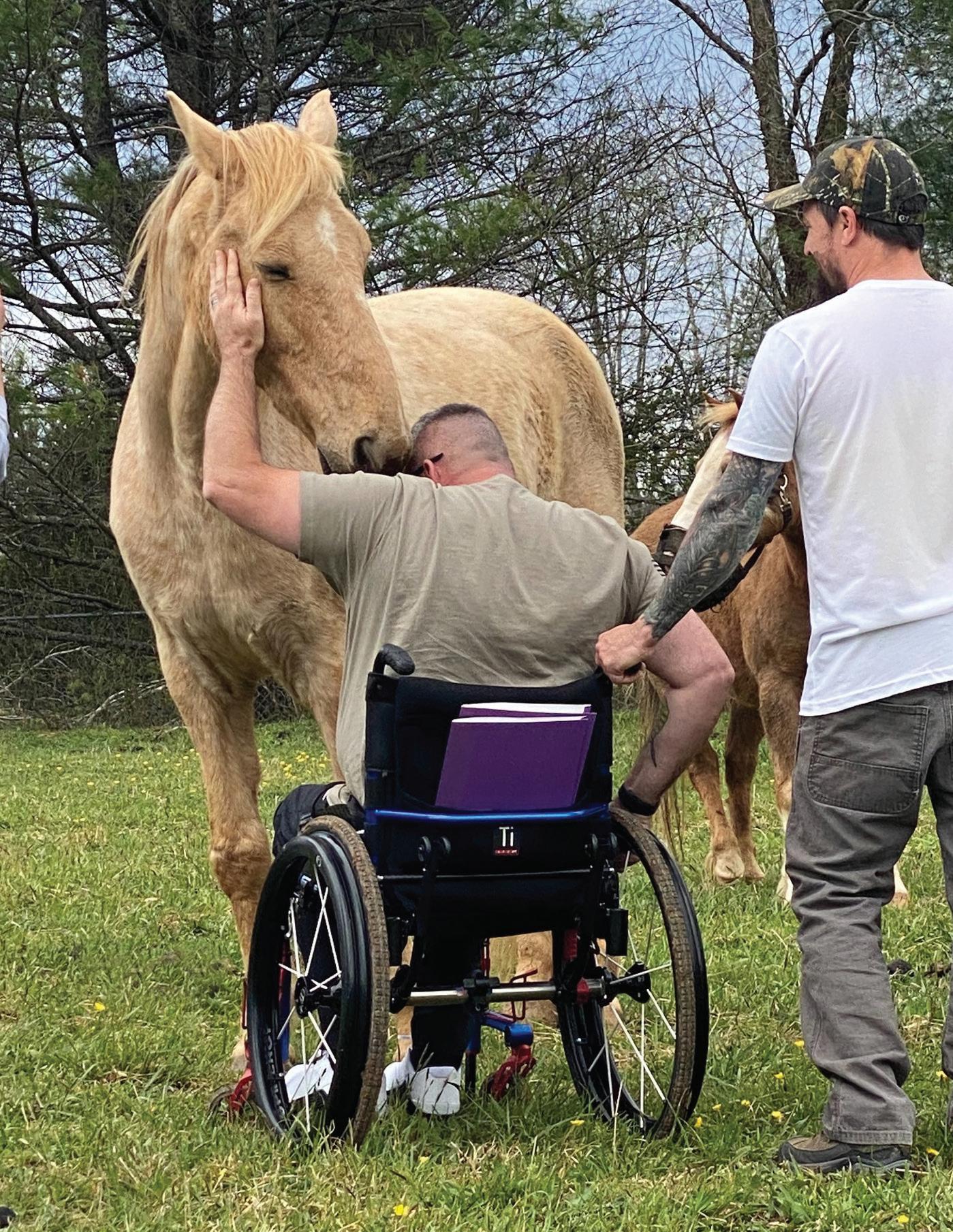
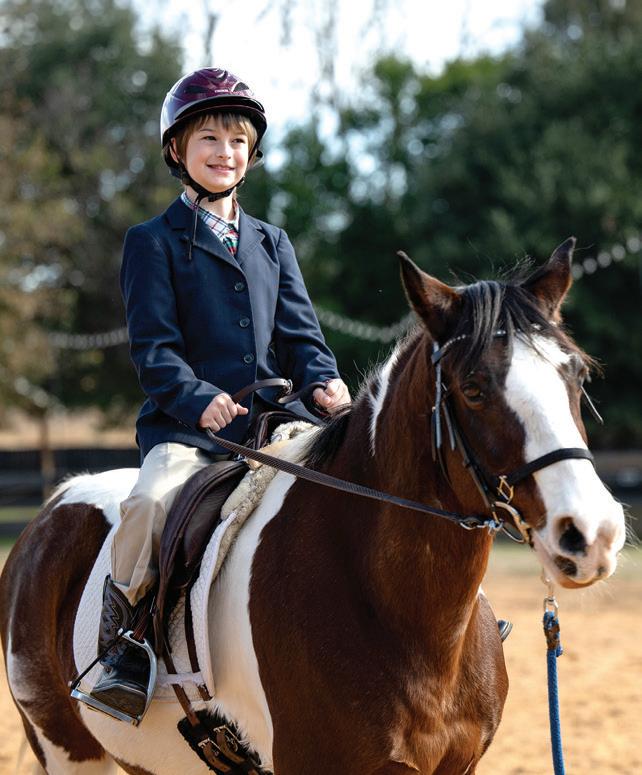
Melear works with horses at liberty, and as the equestrian facilitator, she is responsible for the horses and the physical safety of the client, while a mental health therapist guides the psychological component of the session.
Colleen Trepen, Executive Director of the Charleston Area Therapeutic Riding, Inc. (CATR) says that the first thing everyone says when they visit is “it’s so peaceful here!” CATR is a premier accredited PATH International facility located on Johns Island, South Carolina. CATR employs seven PATH International certified instructors who work together with 150 volunteers and up to 20 horses to serve over 160 children and adults with disabilities every year. Their mission is “to empower children and adults with disabilities to enjoy more active and fulfilling lives through therapeutic horsemanship.”
Trepen says that connecting with a horse is a unique and unforgettable experience. “Horses are extremely intuitive and provide
meaningful feedback to our students. They are incredibly motivating to people.”
Great Oak Equine-Assisted Programs in Aiken, South Carolina is a PATH International facility that provides equine-assisted activities to “promote the physical, emotional, and psychological health of individuals with disabilities.” Great Oak offers equine-assisted learning: “an experiential learning approach that promotes the development of life skills for educational, professional and personal goals through equine-assisted activities.” They have regular riding sessions for individuals with disabilities, and their students compete in the Equestrian Special Olympics. Ann Villa, who is the executive director at Great Oak, says that they focus on offering a safe family environment where they teach the concepts of empathy, compassion and connection through working with equine partners. “We connect to nature and to our herd and through this connection we learn to be
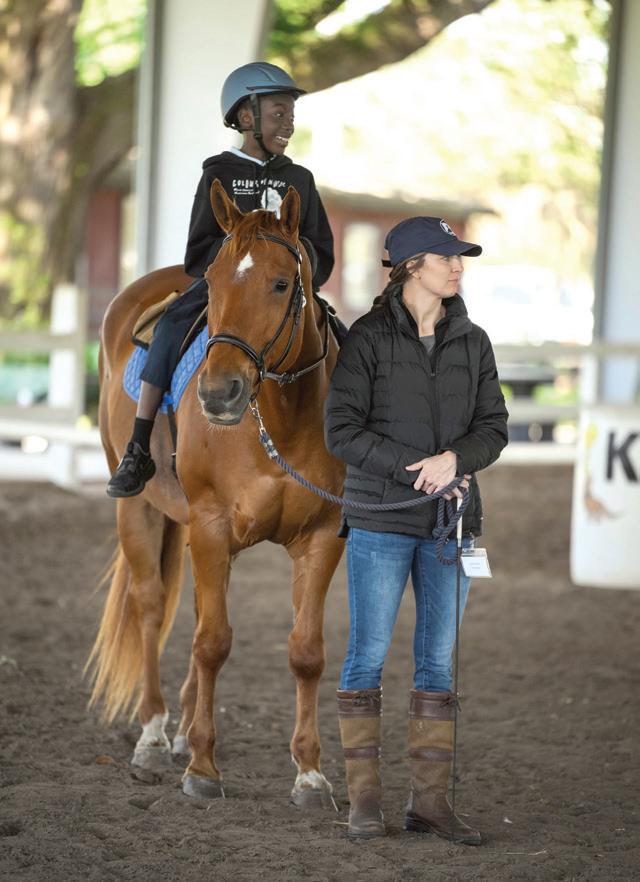
28 The Carolinas Equestrian Spring 2024
Above: Great Oak Equine Assisted Programs
Right: Charleston Area Therapeutic Riding
calm, patient and present. This helps everyone to regulate and to find peace and joy.”
Dream Riders in Lexington, South Carolina is a nonprofit Premier PATH accredited center devoted to the cognitive, emotional, and social well-being of people with special needs. Dream Riders is a family operation: Jennifer Stoudemire and her mother and father Corky and Lewis Dyer developed the program right on the family farm. They observed how powerful horses were in helping Jennifer’s younger brother, Lew, who was born with special needs.
“It is such a passion for us, and definitely our purpose in life” says Stoudemire. Dream Riders offers weekly horseback riding lessons as well as equine-assisted services for foster and underprivileged children and is an approved PATH International Center for the Wounded Warrior Project.
The Marley Project in Camden, South Carolina is a nonprofit dedicated to equineassisted learning, equine rescue, and equinebased public service projects. According to founders Bruce Anderson and Julianne Neal, the goal is to show that “horses are more important now for human wellness, if not survival, than ever before.” Anderson’s system of Natural Humanship™ and Neal’s certification through ARCH are the foundations of their work with groups and individuals through coaching, literacy and educational programming.
Therapeutic Riding of Tryon (TROT) is a program in Tryon, North Carolina at the Foothills Equestrian Nature Center (FENCE), with both mounted and unmounted offerings for adults and children with physical, developmental or cognitive disabilities. Typically, three trained volunteers attend each student in a mounted session, with one volunteer leading the horse and two side walkers there to assist. Unmounted lessons include activities such as caring for the horses and learning about how they interact, and how their actions mirror human interactions. Additionally, “Equine-Assisted Senior Engagement” is a new program at FENCE: a four-week session available in the spring and fall to early-stage dementia and Parkinson’s patients. The goal of the program is to
use equine engagement and sensory experience to enrich the lives of these seniors.
This is only a tiny sampling of the equineassisted options available in our area. For more information, visit the PATH website (pathintl. org) which also contains a search engine to find programs by location with filters for different activities and services. There are 30 programs listed in North Carolina and seven in South Carolina. The ARCH and EAGALA websites also include listings of their accredited programs. Additionally, there are many volunteer opportunities for equestrians who want to get involved, and of course every nonprofit relies on donations from people who care. Meanwhile, give your horse a kiss for being a member of such a noble species and thank him for all the ways he helps you be a better version of yourself.


SPring 2024 The Carolinas Equestrian 29
Asheville Equine Therapy Inc. 29
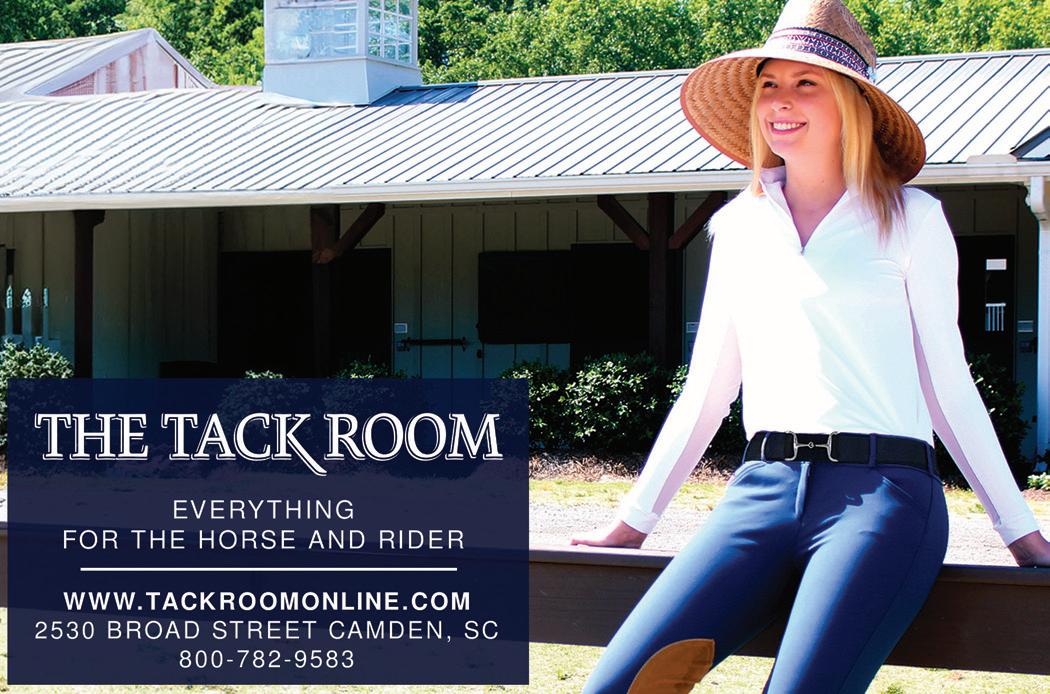
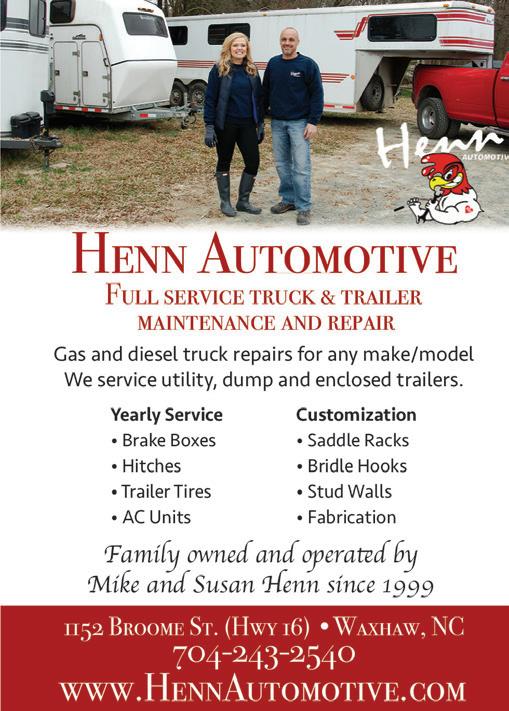






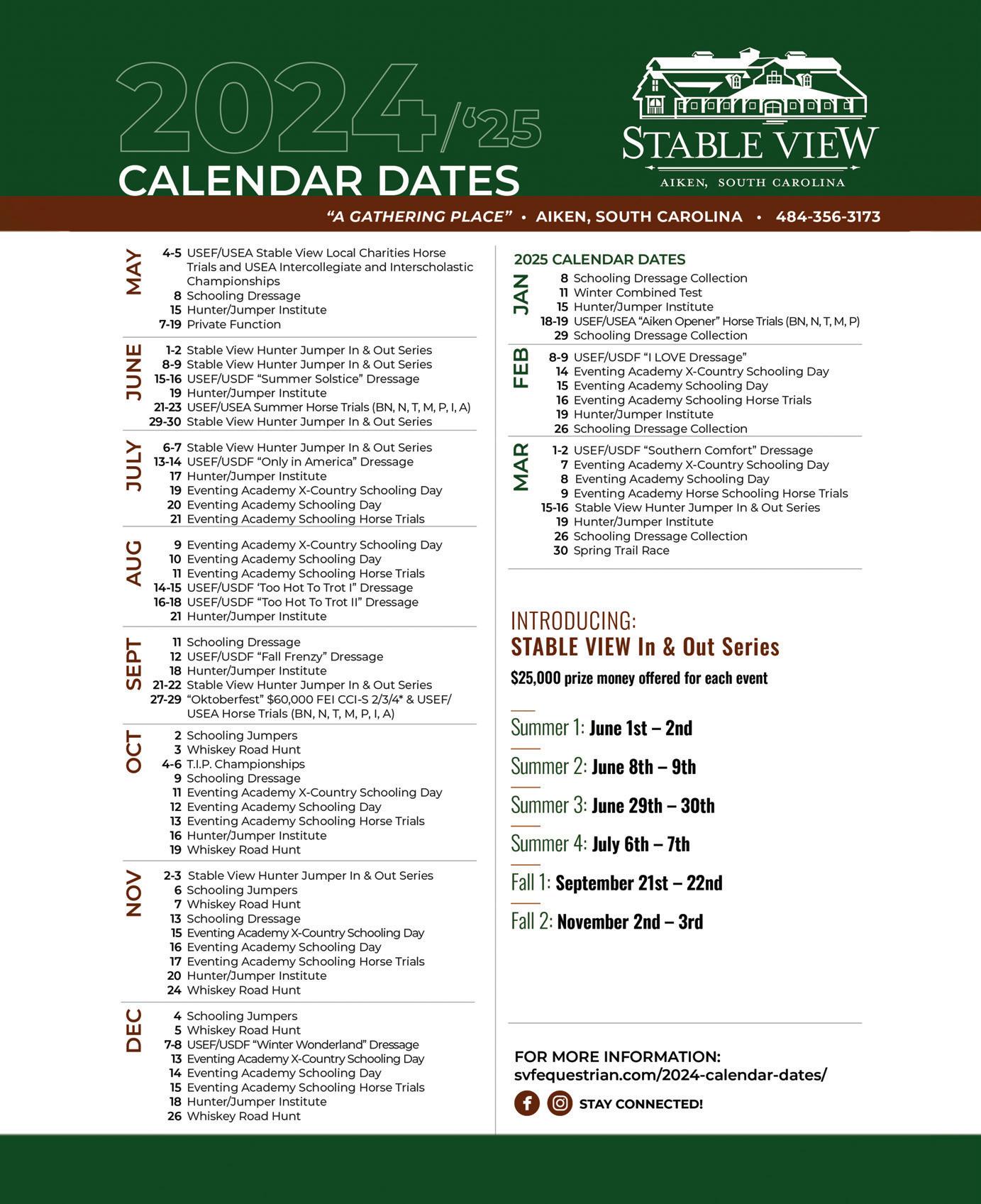
30 The Carolinas Equestrian Spring 2024 Be part of Aiken’s unrivaled, historic charm 100 COLLETON AVE, SW • AIKEN, SC 803.648.1898 • THEWILLCOX.COM luxurious accommodations restaurant & lobby bar • intimate salon & spa vacation rentals • catering

Under 21
Taylor Lovette, Dream Rider
Taylor Lovette may not talk much, but she gets excited if she is talking about horses, especially if she is talking about her favorite horse, Pistol. Taylor is 16 years old and lives with her father and mother, Carlos and Jennifer Lovette, along with her siblings and grandmother in Hopkins, South Carolina. She rides at Dream Riders in Lexington, South Carolina, a nonprofit premier PATH International accredited center devoted to the cognitive, emotional, and social well-being of people with special needs.
Taylor has autism and a physical disability that causes her feet and legs to contract. At 12 years old, she had to have surgery, and after intensive physical therapy she is able to walk again with braces, which she will wear for the rest of her life.
Taylor’s mother says that she began riding as one of the physical therapy programs available through their health care. “We started out in gymnastics, then golf, then we tried horses seven years ago and that’s the one that has really stuck; she has seen the most improvement and also it helps her out mentally, so it’s like a two-for-one deal.”
that she had to be carried around.”
Taylor says that she likes the way the horses look at her, and how smart they are. “I love how they remember who I am.” She says that sometimes they will come and sniff her or lick her.
She enjoys how much her favorite horse likes to go fast, and by all accounts, the two have a special partnership.
“It’s almost like they talk,” Taylor’s mother says. “They communicate well, and if he wants to be spunky, she enjoys that too.” Taylor absolutely loves cantering Pistol: Other horses have been bumpy or scary for her to canter, but Pistol fits her perfectly.

In 2020 when Covid hit and she was unable to ride, Taylor’s legs stiffened up so much she couldn’t walk at all. “We didn’t realize the extent that horses were helping her stay loose and keeping her off her toes” said Jennifer. “The difference was so drastic when she stopped riding
According Jennifer Stroudemire who is the Dream Riders head riding instructor and program director, “Pistol and Taylor found a connection instantaneously. Taylor is one of the few riders he will treat to his lovely canter. This has been a big confidence boost for Taylor.”
Stoudemire would love to see Taylor compete eventually, but she is already incredibly proud of her progress. “To see her go from needing a leader and a side-walker to riding independently is quite the accomplishment.”
Thanks to her experience with riding and discovering her love of horses, Taylor Lovette has visions of working with animals for a career, possibly even becoming a veterinary technician. She plans to volunteer with Dream Riders when she ages out of the program.

32 The Carolinas Equestrian Spring 2024

Modern Hoof Care
It’s an old adage that the hoof makes the horse, but what makes a good hoof? Hooves must be balanced, strong, flexible, and resilient in order to support the horse while he performs his job. And how do you ensure the health of your horse’s feet? You assemble a team of trusted professionals, provide good nutrition, a clean environment with lots of movement, and you pay close attention to them!
 By Lauren Allen
By Lauren Allen
34 The Carolinas Equestrian SPRING 2024

SPring 2024 The Carolinas Equestrian 35

Traditionally, horseshoes have been considered an unavoidable necessity, particularly in competition. Times have changed, and now there are some horses competing barefoot at the highest levels of many sports. Horse shoe technology has also advanced, leaving the equestrian with more choices than ever before, from plastic to aluminum or steel, from hoof boots to glue-ons, to bare feet. There are traditional farriers and barefoot trimmers, and some people are even learning to trim their horses themselves. How do you know what is best for your horse? You must be willing to pay close attention to what works and what doesn’t and try to engage the best team members you can find, from your farrier to your veterinarian and nutritionist.
Farrier Tommy Newman, of Sumter, South Carolina suggests that owners should research the farriers in their area and ask for recommendations from their veterinarian and trainer when choosing a hoof professional.
“You should trust your professional, but also don’t be afraid to ask questions.” Ideally, make sure your farrier works with other clients who are doing what you are doing with your horse, since
the trim and shoeing on a 2-year-old racehorse may not be the same as on a 15-year-old dressage horse. Scrutinize your farrier’s work and make sure that you like how your horse is going. Your horse shouldn’t be sore after a trim and he shouldn’t be constantly losing shoes.
Assess Your Trim
It may seem that there are as many opinions and ideas about ideal trimming guidelines as there are shoers and trimmers, but everyone can agree that every shoer should start with a good trim, and every horse benefits from a well-balanced foot. But how do you know, as your horse’s advocate, what is good and what isn’t good enough?
With the understanding that horses’ feet aren’t all the same, and they’re all attached to legs that may have varying conformation, it is still possible to imagine your horse’s foot compared to a 3D model of the ideal hoof. Viewed from the side, does the hoof continue the line formed by your horse’s leg from the ankle to the toe, or does the angle change dramatically? Does the hoof seem centered under the ankle or is it way out in front? Viewed from the front, is the hoof roughly symmetrical from left to right and does it sit squarely in the center of the horse’s leg or is it
36 The Carolinas Equestrian Spring 2024
skewing off to one side? Ideally, a hoof should be symmetrically balanced and solidly in the middle of the leg from both the front and the back.
Examine the toe: does it seem long? Does it make up two thirds of the horse’s hoof (in which case it probably needs to be brought back by more frequent trims) or is the horse’s foot roughly half toe and half heel? An ideal foot is balanced so that the toe is not pulling the foot longer and more forward as it grows.
Heel: is the heel giving ample height to keep the back of the foot off the ground or is the heel short and underrun? Rebalancing an underrun heel
flourish in the damp, anaerobic environment of the foot and can gravely affect the health of this tissue that is crucial to shock absorption.
Concavity: the hoof is meant to be a bowl shape, not flat. As ancient builders discovered, the arch is an incredibly strong form, able to support far more weight than a flat surface. The foot needs to be strong to stand up to all the force it encounters, and the hoof’s arch is what allows it to expand and contract, absorbing shock and pumping blood back up the leg.
No two feet are the same, and not all hoof problems originate in the foot – some are

and long toe gets harder and harder as the long toe becomes a lever that generates biomechanical forces that perpetuate the unbalanced growth pattern.
Commissures (the grooves that mark the juncture of the frog and the sole): these grooves are kept clean with a hoof pick, otherwise they tend to pack dirt and manure and can be a site of bacterial overgrowth that can eat away at the sensitive interior tissues of the foot. Are the commissures on your horse’s foot deep, dark and narrow or are they wide and just deep enough to get your pick into?
Frog: Is your horse’s frog fat and healthy? Does the center of your horse’s frog (called the sulcus) have a deep slit? If so, you likely have a problem with thrush that needs to be treated. Bacteria
conformational and some reflect environmental issues, diet, or structural issues elsewhere in the body. Hoof health requires that horses have clean, dry spaces and good nutrition. Horses need turnout, hay in variable positions and locations, and regular exercise. The horse’s body systems are intricately connected and each part must function well for whole-horse soundness.
Take a close look at your horse’s hooves and see what you think. If you don’t like where things are going, you might want to take your questions to your team of professionals. Hopefully you like what you see, in which case you might find a way to tell your trimmer or farrier that you’re grateful. No matter what, the more you know, the better you can support your horse’s health. Great care starts from the ground up.

SPring 2024 The Carolinas Equestrian 37
Going Barefoot
With Shelley Onderdonk, DVM
Dr. Shelley Onderdonk is a certified veterinary acupuncturist and equine veterinarian practicing integrative medicine in Aiken, South Carolina. She is also an amateur three-day eventer, and her husband Adam Snow is a semi-retired former 10-goal polo player. They have written a book called Winning With Horses where they share their efforts to keep and train horses in a natural way, including their journey to leaving their horses mostly barefoot and taking on the task of trimming themselves.
“Everybody is just looking for their horses to be sounder, healthier, more natural. I am always asking myself, for my horses and clients’ horses, ‘What is in their best interest?’ Often the things that are in their best interest are things that coincide with what nature intended.”
For Dr. Onderdonk, this includes taking a horse’s shoes off whenever possible and turning horses out together for social stimulation and exercise. She points out that one of the benefits of being barefoot is that it is not as dangerous if one horse kicks another as it is when they are wearing shoes.

Dr. Onderdonk says that she and her husband pulled their horses’ shoes off when they were on a break, and started thinking, ‘Well maybe we can keep them barefoot while they’re getting legged up.” And soon it was, “Well maybe we can keep them barefoot all the time.”
“It’s experimentation, basically . . . what level of use you can get away with them being barefoot. That varies from horse to horse and with levels of injury, etc. We are working in Aiken mostly on turf and sand, which is a very forgiving surface and I recognize that not everybody has that luxury.
“Nutrition is incredibly important in hoof growth, and exercise is important, too. One of the benefits of barefoot is you get that good stimulation of the frog and the heel, and the digital cushion; all the structures working the way that nature intended, which is to absorb concussion and to be flexible and move with the weight coming on and off
with every step.”
Dr. Onderdonk says that a horse’s nutritional needs must be gauged on an individual basis, but when trying to boost hoof growth and health she likes to ensure that horses are getting 30 mg of biotin per day.
Hooves grow at different rates and can vary over the seasons. Sometimes in the summer Onderdonk trims every three weeks and sometimes in the winter it’s up to seven weeks before the horses need a trim. Another benefit of having a horse barefoot is access to the foot: if adjustments need to be made on a shorter cycle, there is no shoe in the way.
Dr. Onderdonk remarks that trimming your own horse is physically very challenging, but she thinks if an owner is interested and willing to learn, it is a great idea. “I think it’s definitely accessible . . . if they put the time in to learn to trim and they have the interest, I think it’s really great for the relationship with your horse.” There are people who critique pictures and offer trim advice online, in addition to Facebook groups dedicated to trimming and farriery. Onderdonk recommends a book called The Essential Hoof Book by Christina Cline and Susan Kauffmann.
“The most important thing for excellent hoof care is to find a good farrier, whether that is a barefoot trimmer or a shoer. It is an art and there is so much judgement in every single horse, every single foot. Actually, doing it myself has helped me so much with understanding the biomechanics and the nuance of every single choice.”
 Dr. Shelley Onderdonk and Adam Snow at their farm in Aiken.
Dr. Shelley Onderdonk and Adam Snow at their farm in Aiken.
38 The Carolinas Equestrian Spring 2024
Photo by Robb Scharetg
Hoof Evaluation: A Professional Perspective
With Shawn Morrell, DVM
Dr. Shawn Morrell is a veterinarian specializing in equine veterinary podiatry. He is on staff at Rood & Riddle Equine Hospital in Saratoga Springs, New York but lives in Aiken, South Carolina. Dr. Morrell shared his insight on evaluating the equine hoof.
“Horse owners should be familiar with the horse’s body condition, the conformation of the horse’s limbs, and the appearance of the horse’s feet,” says Dr. Morrell. “The equine hoof is an important structure for the equine locomotor system. It is the foundation that supports the entire horse and is integral for motion. Understanding the anatomy and function of the foot, as well as other factors that can influence the foot are important for managing the comfort of the horse.”
Dr. Morrell suggests examining the horse in a quiet area with a clean, flat surface. The examination should begin with an evaluation of the horse’s body condition, his limb conformation and the appearance of the hoof capsule, which includes the hoof wall, the sole, the frog, the coronary band and the heel bulbs. After brushing off dirt and picking out the bottom of the foot, examine the shape of the hoof capsule and make note of any distortions. Look for cracks, cavities and any obvious defects. These might include foul odors or draining tracts. Be aware of when the horse was last trimmed or shod, since a foot that was recently attended to will not look the same at the end of the cycle.

the limb. I examine the growth pattern (observing the spatial alignment of the ‘growth rings’) of the hoof capsule and look for any signs of injury/distortions/ pathology. Then I pick up the limb and observe the solar (ground) surface of the foot. I evaluate the shape of the capsular circumference, the solar structures (hoof wall, white line, bars, sole, frog, commissures) and look for signs of injury/ distortions/pathology.”
Next, Dr. Morrell observes the horse in motion. He looks closely at how the feet land, watching for any signs of discomfort. In an ideal world, a horse’s legs should be straight so that the structures of the limb are under a balanced load. There is no such thing as a perfectly straight leg, but any crookedness can cause excessive weight bearing on certain areas of the foot, which in turn will cause the hoof capsule to distort. But even if the hoof looks perfect on the outside, that does not guarantee that the internal structures are healthy.
“As a veterinary equine podiatrist, I evaluate the equine hoof for every single case that I work with,” says Dr. Morrell. “Before evaluating the horse, I will ask questions about the history of the horse:
• Is the horse lame or is it sound?
• When was the horse last trimmed/shod?
• What problems involving the feet or lameness are we evaluating for?
• What concerns does the rider have regarding the feet?
• What type of footing is the horse on?
• What does the horse’s diet consist of?
• Has the horse had any past issues with the feet/lameness?
“Once a history has been established, I like to consider the horse’s body composition as well as limb conformation while they are standing square on a level surface. Next, I look at the hoof capsule conformation and its relationship to
“A set of radiographs are beneficial for evaluating the bones of the foot and digit,” says Dr. Morrell. The relationship between the bones and hoof capsule can help the hoof care provider determine the best course of treatment for addressing lameness issues. For soft tissue injuries, more advanced imaging such as venography and magnetic resonance imaging may be useful for a more thorough damage assessment.
Dr. Morrell says that other factors also influence the health of the feet. For instance, deficiencies in the diet may result in weakened hoof walls that can chip or develop superficial wall cracks.
“The hoof capsule is analogous to the skin. It is an epidermal structure that is a physical protective barrier to disease. A healthy hoof capsule should be intact. The presence of cracks, cavities, or draining tracts may indicate injury, significant capsular distortion, or active pathology of the foot.”

SPring 2024 The Carolinas Equestrian 39
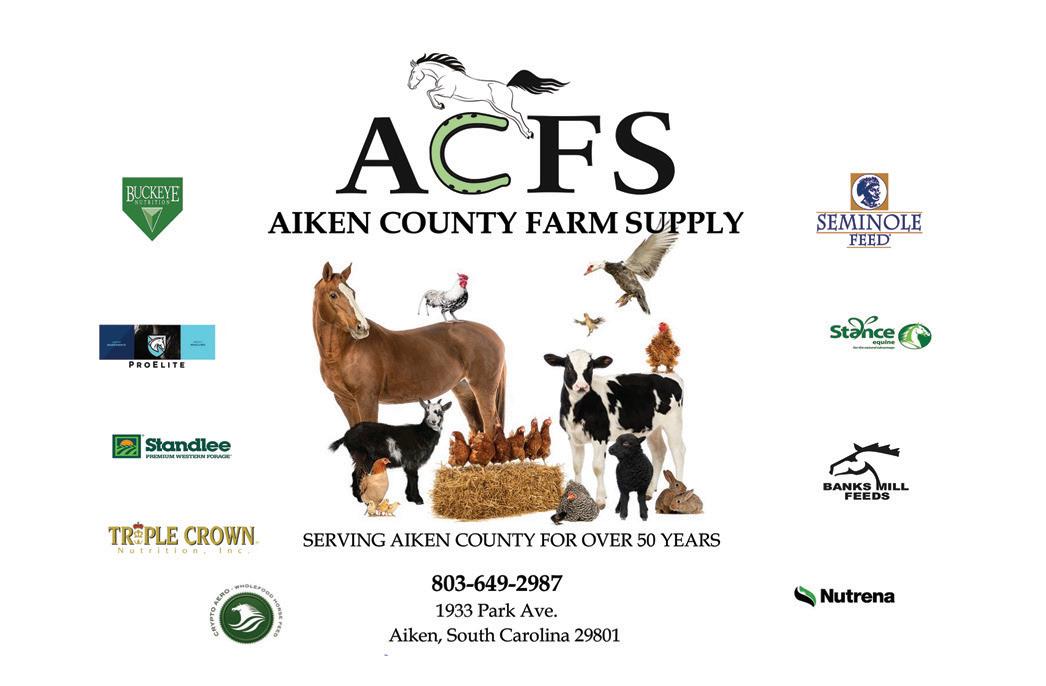





40 The Carolinas Equestrian Spring 2024 60-acres with 9 Barns, 288 Stalls, 5 Show Rings (3 Outdoor, 2 Covered Arenas), Cattle Pens, Generous Space For Schooling, RV Parking, Cafe’, Pavilion & more 443 Cleveland School Rd Camden SC 29020 I-20 Exit 101 Mailing Address P O Box 2174 Camden SC 29020 scequinepark.com For Booking Information contact Leon Rembert 803-229-0057 or camdenhorseshows@gmail.com Scan the QR Code or visit scequinepark.com to Donate Online Follow us for Updates and More Name A Stall or Become a Park Sponsor with Signage & more! Email inntamara@gmail.com for details We Look Forward To Seeing You Ringside! Your Camden Showgrounds South Carolina Equine Promotion Foundation, a 501c3 non-profit organization not state funded


SPring 2024 The Carolinas Equestrian 41

The Healing Power of Horses
The ArT of TAmmy TAppAn
By Lauren Allen
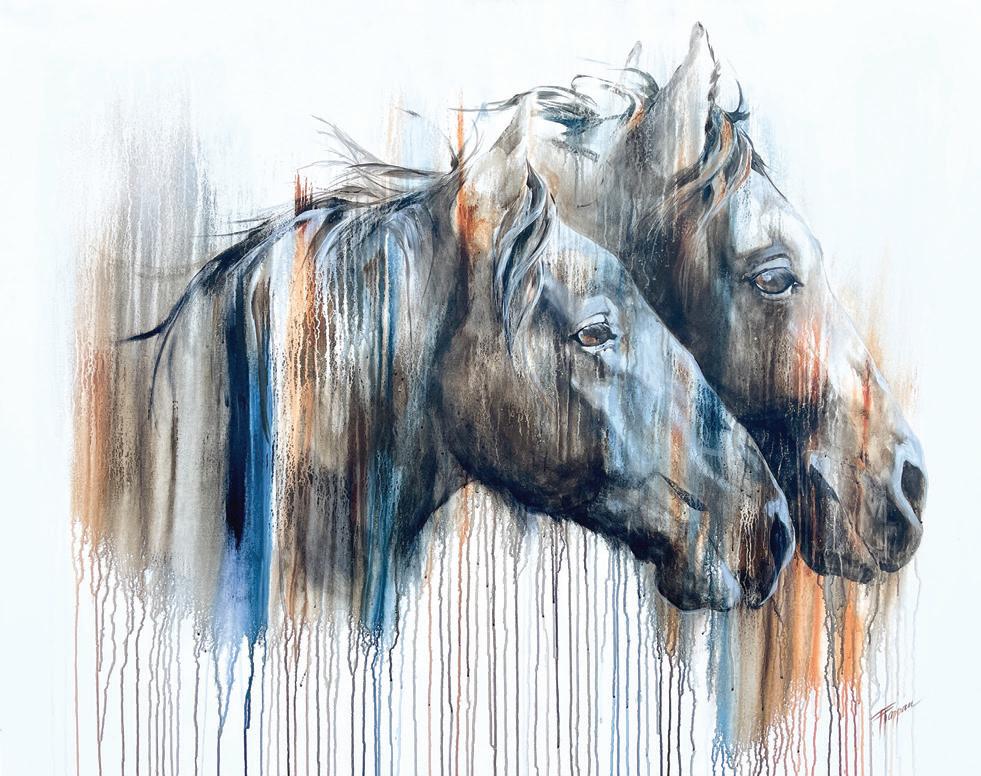
Tammy Tappan has made a home for her equestrian art studio right in the middle of the Tryon International Equestrian Center in Mill Spring, North Carolina.
“I decided if you are going to create horse art you probably ought to be where the horse people are,” she laughs. Tappan moved her studio to Tryon International in 2018, just before the World Equestrian Games, which were held at the facility that year. Initially she gave herself three months to see how things went. She reports agonizing self-doubt during the first three weeks, when she didn’t sell anything at all. But then she sold a handful of bronze sculptures to a buyer for a sum that exactly covered the cost of the first three months rent. “Ever since then it has just worked.”
“I wasn’t always an artist. I owned a sign company for almost 30 years,” Tappan says. She grew up in Michigan, with horses as part of her childhood. “I did the 4-H, always had Appaloosas
or somebody’s left over horse; did some dressage,” she says. “I am not really a competitor, but I am a horse lover; I enjoy the relationship and I like having them in my space.” She also always had a creative inclination, but she dropped out of art school in her second year when her father asked “But what are you going to do for real?”
So she raised two children while running a business developing signs and branding for communities and golf courses. Then, at the age of 50, she pulled a U-turn on her life trajectory.
“I had one of those epiphanies one day, and I Googled equine sculpture. I found a five-day workshop out in Scottsdale, Arizona and decided I was going to give it a shot, and that is how I got started. There were about six other people. I was the only one who had never touched clay before. But at the end of the five days, I knew this was what I was supposed to be doing. It was lifechanging. To be able to create with your hands in three dimensions what you see in your mind is so much fun for me.
SPring 2024 The Carolinas Equestrian 43
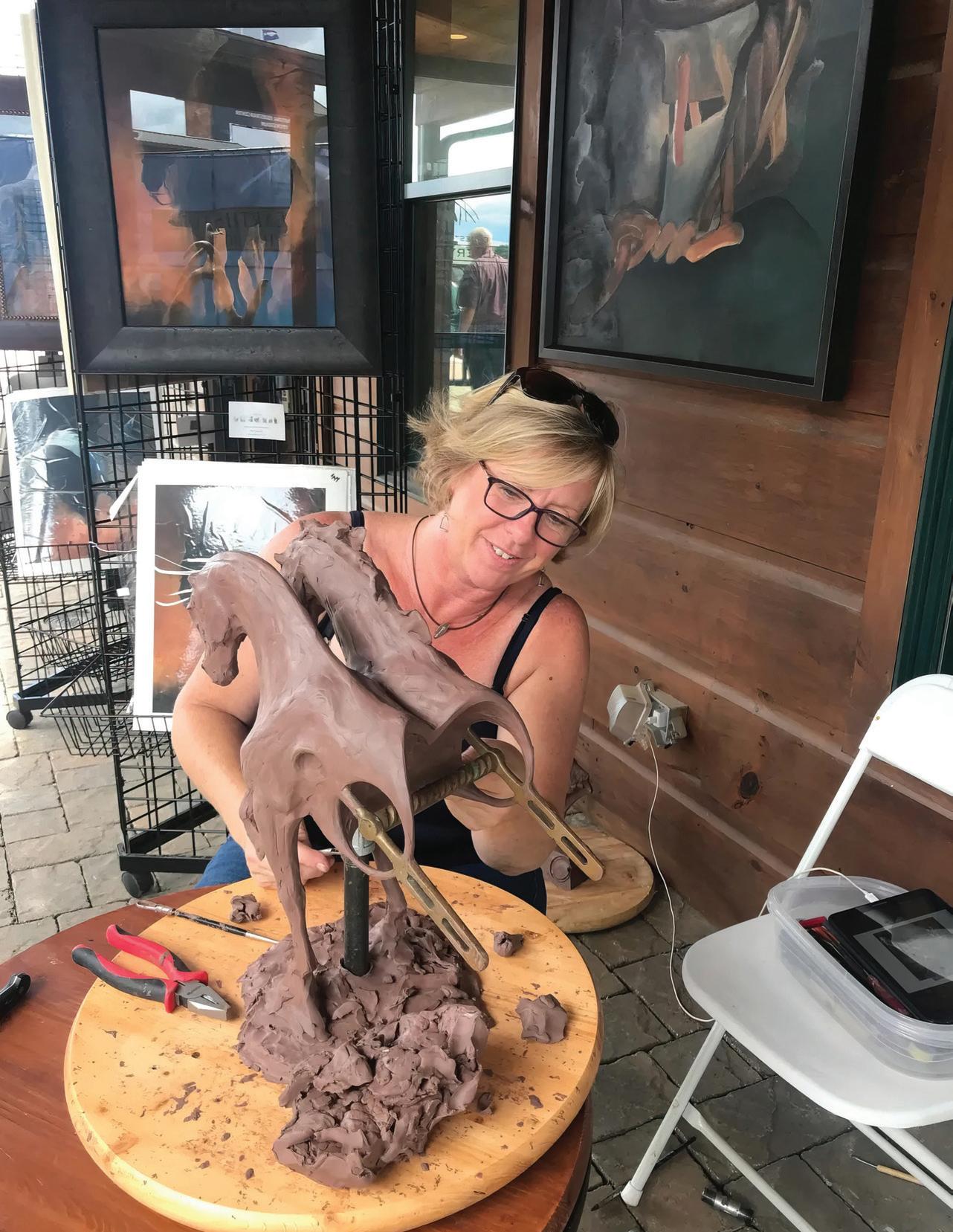

“The healing aspect of horses is the driving force. Because of the art, I have been able to see the connections that people have with their own horses. I believe that horses have an energy that we don’t completely understand, but that promotes healing.”

SPring 2024 The Carolinas Equestrian 45
“I want to do what I am passionate about, and I couldn’t think of anything I would rather draw or paint,” says Tappan, who is endlessly inspired by the equine form. “The healing aspect of horses is the driving force. Because of the art, I have been able to see the connections that people have with their own horses. I believe that horses have an energy that we don’t completely understand, but that promotes healing.”
Tappan regularly donates and supports equine therapy programs: she specifically mentions a program called HOOVES in Ohio, that uses rescue horses to facilitate healing for veterans. “That piece of our world is important” she says. “I love the whole of the equine industry, but the therapeutic aspect is the one I am most drawn to.

“By painting horses, you open a conversation with people and give them a common ground,” she continues. “It happens several times a week, where people will walk in and stand in front of a painting or a sculpture, and I can see that they are emotional. They start talking about this horse and its eye, or this painting and its relationship, and they are having this very emotional response, not because of the actual artwork but because it has triggered something that is going on in their own life, and we end up having these deep conversations…There is this triangle between the horse and the connection with people that I try to facilitate, but it happens organically.”
Tappan actually began painting to fill time between casting sculptures, which, for monumental bronze pieces, is an expensive and slow process. There are only a few foundries in the country: Tappan works with one in Montana and one in Austin, Texas. Coordinating getting a 5-foot-tall sculpture across the country is an undertaking, in itself. “I could sculpt fairly quickly, but then you take a piece to the foundry,
and the cost of the mold and the casting is daunting, so I started to paint in between as a way of funding the process,” Tappan says.
Tappan’s paintings have a distinctive composition, with images loosely developed in paint dripping down the canvas and yet somehow crystallizing the essence of the horse with a sure stroke.
Tappan’s signature style has also changed course dramatically: she used to paint in a hyperrealist mode. “When I am painting, most of the time now, I am less concerned about putting the entire horse. I want the focal point to be the horse’s eye – there is an energy and you can see into their soul.
“The dripping thing was a complete accident,” she admits. “I was in the studio, and someone walked in—I work in acrylics, and in the summer heat they dry fairly quickly, so I had a spray bottle and I misted the canvas to keep the paint open and movable while I turned away for a minute . . when I turned back, the whole piece had slid down the canvas!” She laughs. “Now I’ve turned it into a process, but I start with a completely blank canvas and just go in and lay down color and spray it and walk away. About 50% of the time, I have a clear idea of what I am working on, but the others they feel like they come through me.”
Tappan finds that bouncing back and forth between painting and sculpting horses gives her the perspective she needs while allowing for the practical down-time necessary for paint or clay to dry. “Sometimes walking away and coming back with fresh eyes is important. I am not looking for perfection; I am looking to convey a message. I think that was part of the process of learning to let go with the paintings and loosen up.”
Tappan can usually be found in her studio at Tryon International Wednesday through Saturday from around 10 AM until about 5 or 6 PM. Visit her website at TammyTappanArt.com

46 The Carolinas Equestrian Spring 2024
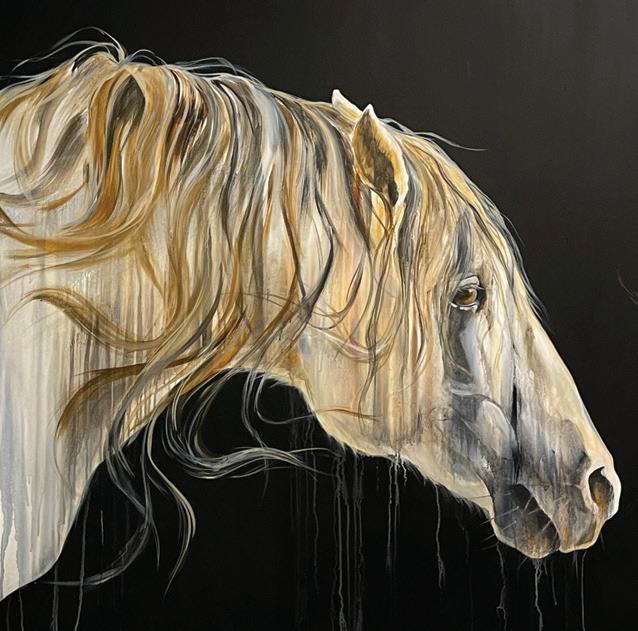



SPring 2024 The Carolinas Equestrian 47
Index of Advertisers

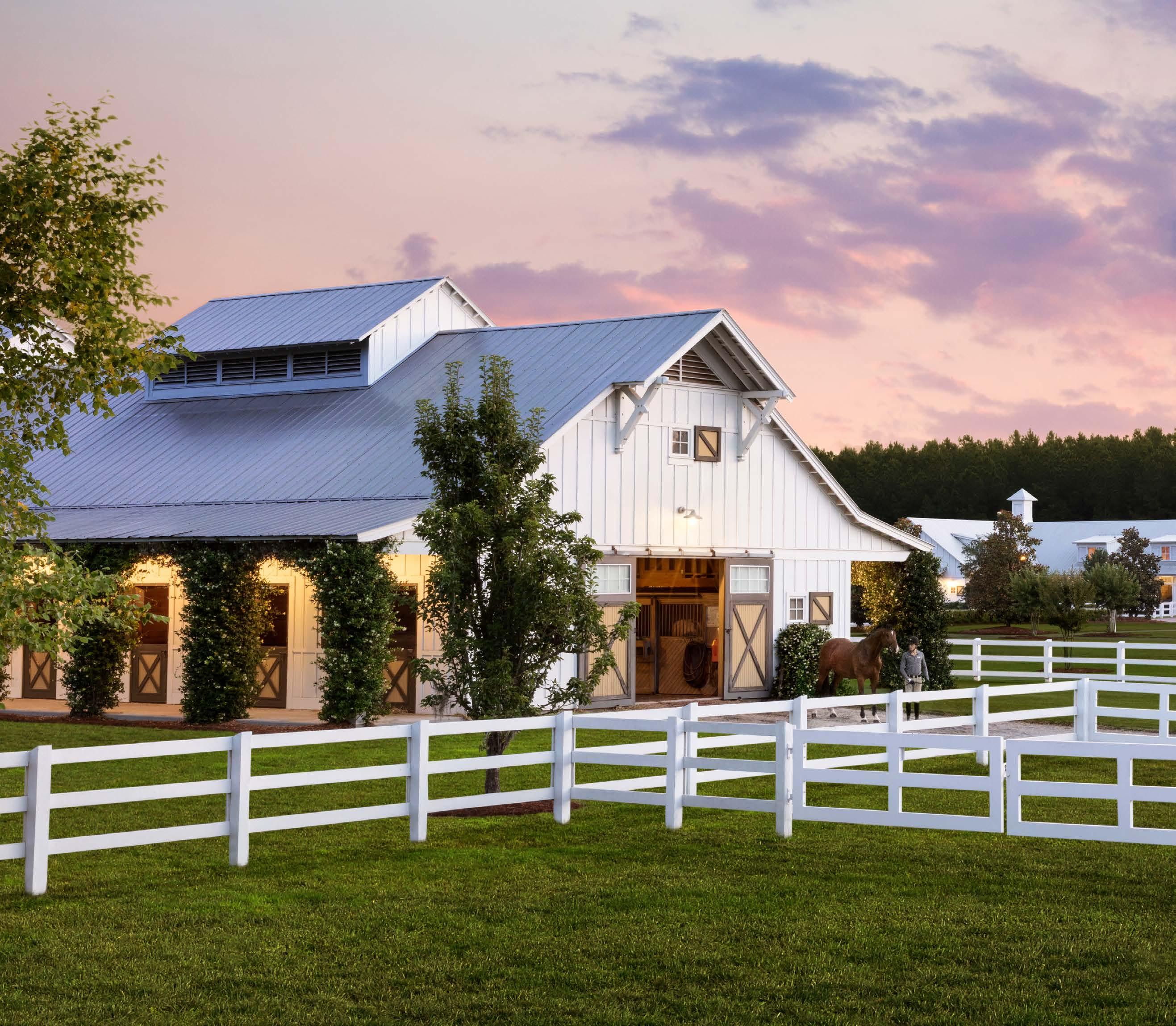



ADVERTISE IN OUR SUMMER 2024 EDITION! CONTACT US! Our space reservation deadline is MARCH 15, 2024 and the issue will be out in April 2024. Check out the full ad rates and advertising guidelines on our website: thecarolinasequestrian.com, or contact us for more information. Lauren Allen, Camden SC thecarolinasequestrian@gmail.com 803-270-1275 Pam Gleason, Aiken SC thecarolinasequestrianllc@gmail.com 803-643-9960 Ashley Haffey, Troutman, NC ads4thecarolinasequestrian@gmail.com 607-743-1309 Aiken County Farm Supply 40 Aiken Polo Club 51 Aiken Saddlery, Inc. 21 Bent Oaks Labradoodles 41 C2 Equine 5 Camden Hunter Jumper Series 15 CHAPS 17 Clint Bertalan Farms LLC 41 DFG Stables 21 EMO 2 Equine Divine 10 Haven Real Estate 52 Henn Automotive 30 High Meadow Pastures 48 Highfields 16 Hunter’s Trace 11 LEGISequine.com 4 Olive Branch Farm 11 Poll to Pastern 48 Red Patriot Farms 17 Roslyn the Pet Psychic 48 Savannah College of Art and Design 49 SC Equine 17 South Carolina Equine Park 40 Stable View, LLC 31 Sullivan Turner Team | Meybohm RE 3 The Tack Room 30 The Willcox 30 Tryon International Equestrian Center 15 48 The Carolinas Equestrian Spring 2024
Tyler Graham

• World-class equestrian center
• Exceptional equestrian studies program
• National championship team Your future is bright at SCAD.
SPring 2024 The Carolinas Equestrian 49 The Art of Horsemanship
To learn more about SCAD equestrian or explore other award-winning programs,
visit scad.edu or email admission@scad.edu.

Parting Shot
50 The Carolinas Equestrian Spring 2024
Will Faudree of Hoffman, North Carolina takes P-Fun down the formidable Barton’s Pond Broken Bridge at the $100,000 Conceal Grand Prix Eventing Showcase, Aiken Horse Park, Aiken, South Carolina. P-Fun is a 2007 Irish Sport Horse gelding owned by Jennifer Mosing. Photography by Pam Gleason.
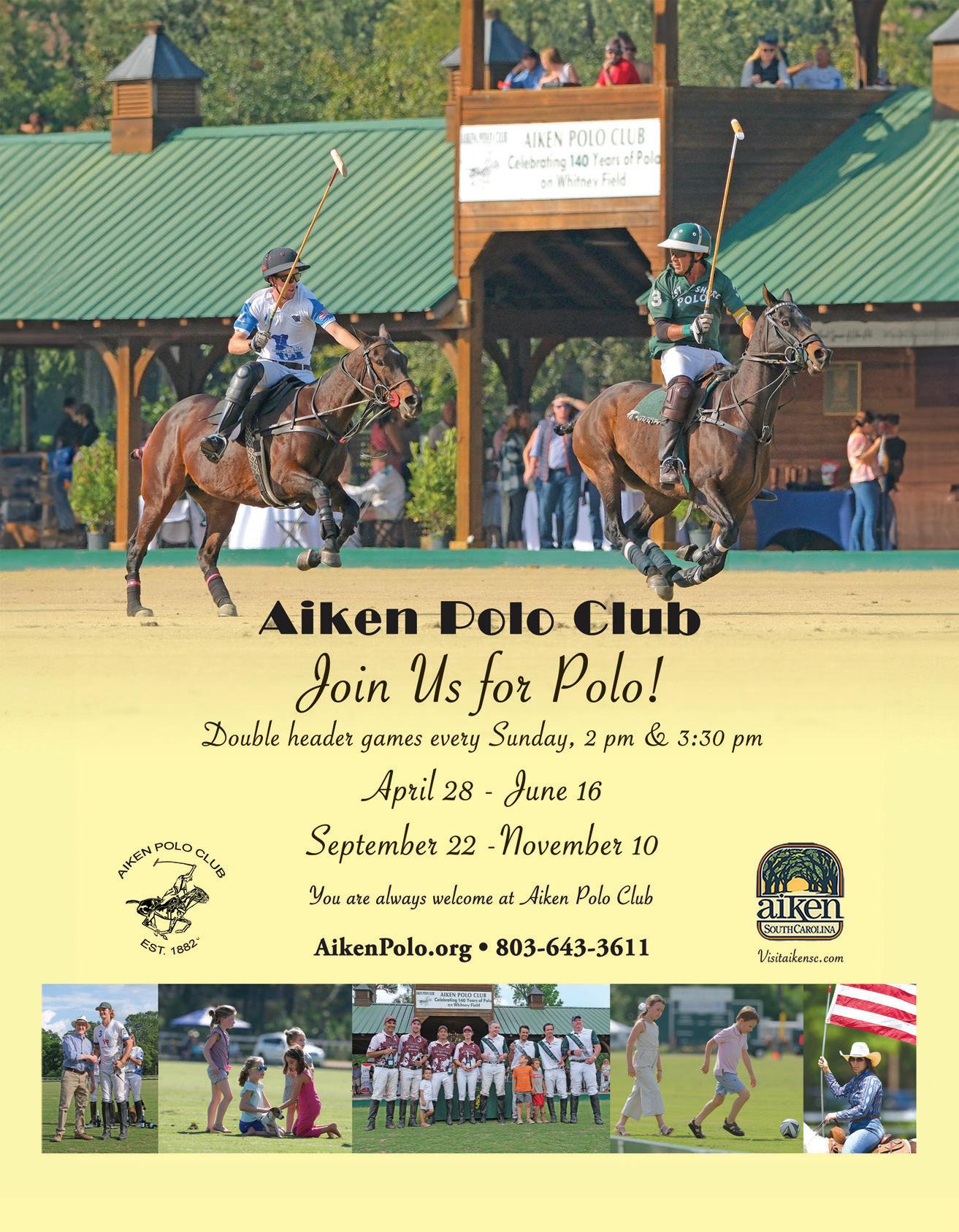


There is No Place Like Aiken 843.834.1226 Aiken, South Carolina www.haven-sc.com



















































 The Marley Project
The Marley Project















 By Lauren Allen
By Lauren Allen































